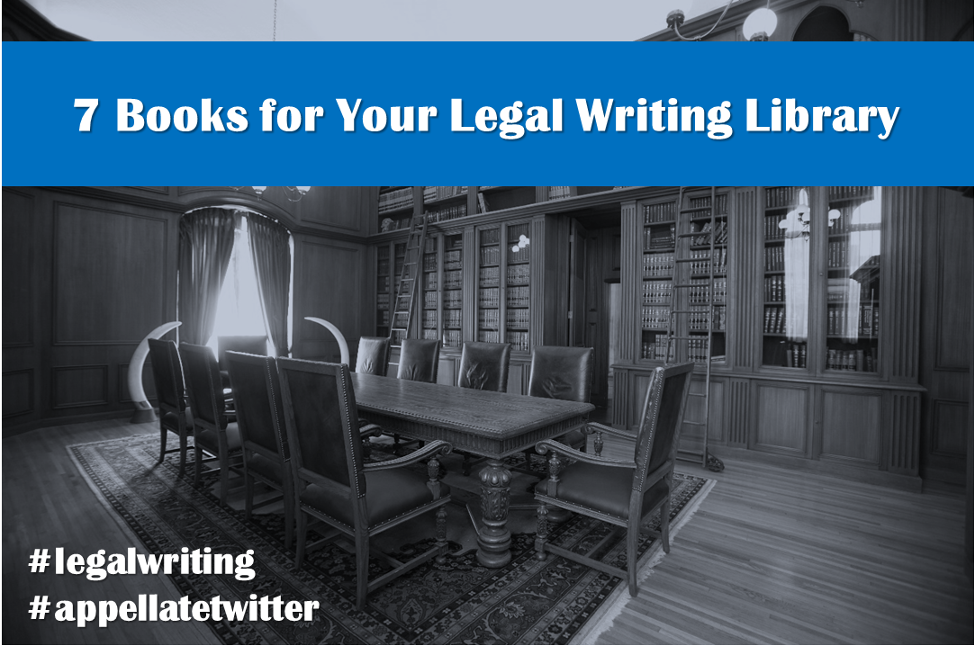Your legal writing reference library should include more than the five standards: the Bluebook, the Redbook: A Manual on Legal Style, A Manual of Style for Contract Drafting, Garner’s Dictionary of Legal Usage, and Black’s Law Dictionary. There’s more to writing than mechanics and accurate definitions, and these books prove it. From universal rules and styles to advice that will change your process and your results, here are seven books (in no particular order) to make your writing better.
1. The Lawyer's Editing Manual
By Joan Ames Magat (125 pages, Carolina Academic Press, 2009)
The most well-known manual for lawyers is the Bluebook: A Uniform System of Citation, which does not address effective legal writing or analysis. Author Joan Ames Magat recognized that gap and created The Lawyer’s Editing Manual to fill it. It covers effective use of quotations, grammar, punctuation, usage, and style. In this manual, Magat gets into the details of word choice and modifier placement to avoid ambiguity, structure sentences and paragraphs effectively, and improve conciseness and consistency. Magat is a law professor at Duke Law School and the general editor for the Law & Contemporary Problems Journal. Magat is known for her academic article “Bottomheavy: Legal Footnotes.”
2. The Lawyer's Guide to Writing Well
By Tom Goldstein and Jethro K. Lieberman (296 pages, University of California Press, 2016)
The Lawyer's Guide to Writing Well presents direct and sensible legal writing advice supported by clear reasoning and research. Besides offering straightforward writing advice, the authors analyze the causes of poor legal writing and address its consequences. In this guide, you’ll find advice for writing concisely and persuasively, an editing checklist and revision exercises to test your understanding, and effective strategies to improve your writing. Author Tom Goldstein is a journalism professor at UC Berkeley and Jethro K. Lieberman is a law professor at New York Law School. Lieberman is also the author of 25 other books, including The Litigious Society.
3. Plain English for Lawyers
By Richard C. Wydick and Amy E. Sloan (162 pages, Carolina Academic Press, 2019)
Plain English for Lawyers is a short, quick book, written in the style it means to teach: plain English. It’s clear, concise, and practical—and even clever. Though the authors address grammar rules, the emphasis is on how the writer must work to understand the material so she may write in plain language to benefit the reader. In January 2005, co-author Richard C. Wydick received the Golden Pen Award for this book from the Legal Writing Institute. Wydick was a law professor at UC Davis for 32 years. Co-author Amy E. Sloan is a law professor at the University of Baltimore and joined the team to update the book in its sixth edition.
4. Legal Writing Nerd: Be One
By Wayne Schiess (162 pages, CreateSpace Independent Publishing Platform, 2018)
Legal Writing Nerd: Be One grew out of author Wayne Schiess's monthly column on legal writing. This book is a curated collection of his best columns in one practical guide. Though it can be a reference manual, readers can also enjoy Legal Writing Nerd like a novel. Schiess’s chapters on professionalism and plain language make great points in an accessible and friendly tone so they’re a joy to read again and again. Schiess is a legal writing professor at the University of Texas School of Law, and he was recognized by the Center for Plain Language in 2010. He’s also the author of four other books, including Plain Legal Writing: Do It and Writing for Litigation (co-authored with Kamela Bridges).
5. Plain Language Legal Writing
By Cheryl Stephens (152 pages, Lulu.com, 2009)
The author’s brand is Plain Language Wizardry™ and this book delivers the magic—while making it all seem natural. Rather than an opaque list of commands, Plain Language Legal Writing is a guide to clear and understandable writing filled with traditional and revised writing examples with instructions on how to achieve those results. Author Cheryl Stephens emphasizes the importance of writing as communication, which requires writers to know what message they want to deliver. The book is divided into four parts, each with a different focus: clarity and organization; issues with traditional legal writing; formatting and presentation options; and resources and references. Stephens is a plain language advocate, the co-founder of the Plain Language Association International, and a former practicing lawyer.
6. Grammar, Punctuation, and Style: A Quick Guide for Lawyers and Other Writers
By Deborah E. Cupples and Margaret Temple-Smith (157 pages, West Academic Publishing, 2013)
Grammar, Punctuation, and Style: A Quick Guide for Lawyers and Other Writers is an accessible writing guide that is generally useful, but specifically designed for lawyers. Acknowledging that this book will be used as a reference -- rather than read straight through like a novel -- means the easy-to-use index is a key feature. The book includes exercises to test your understanding of the rules and includes answers with explanations. Authors Deborah E. Cupples and Margaret Temple-Smith are both professors at University of Florida, Levin College of Law.
7. How to Write a Sentence: And How to Read One
By Stanley Fish (176 pages, Harper Collins, 2011)
One of the first sentences author Stanley Fish discusses in this book comes from the significant school-prayer case, Lee v. Weisman (1992). It’s a scathing line from Scalia’s dissent—it’s penetrating and memorable. Fish spends the rest of the book exploring and explaining how sentences like this are built and why they move us. It’s a strategic approach to writing focused on the smallest building blocks of meaning. Fish is a law professor at Florida International University, a New York Times best-selling author, and the author of more than 10 other books.
Looking for More Legal Writing Help?
Sign up here to receive weekly writing tips from WordRake founder and legal writing expert Gary Kinder. And check out WordRake’s eBooks about legal writing:
Looking for Help Formatting Legal Documents?
Check out:
- The Lawyer's Guide to Microsoft Word 2013 by Ben M. Schorr
- Formatting Legal Documents with Microsoft Word 2016 by Jan Berinstein, Ph.D.
- Wildcard Cookbook for Microsoft Word by Jack Lyon
Conclusion
Becoming a great legal writer is an ongoing process. With more approaches, examples, and explanations, you’ll have more opportunities to find an approach that works for you. So try expanding your legal writing reference library to include some of these books. When you’re ready to take the next step, let WordRake help you tighten and tone your legal writing at the push of a button. WordRake uses complex, patented algorithms to find legalese, wordy phrases, redundancies, unnecessary modifiers, and more. Then it presents its suggestions to you in the familiar track-changes style. It can make any document clearer and shorter. Try WordRake free for seven days!
About the Author
Ivy B. Grey is the Chief Strategy & Growth Officer for WordRake. Prior to joining the team, she practiced bankruptcy law for ten years. In 2020, Ivy was recognized as an Influential Woman in Legal Tech by ILTA. She has also been recognized as a Fastcase 50 Honoree and included in the Women of Legal Tech list by the ABA Legal Technology Resource Center. Follow Ivy on Twitter @IvyBGrey or connect with her on LinkedIn.








